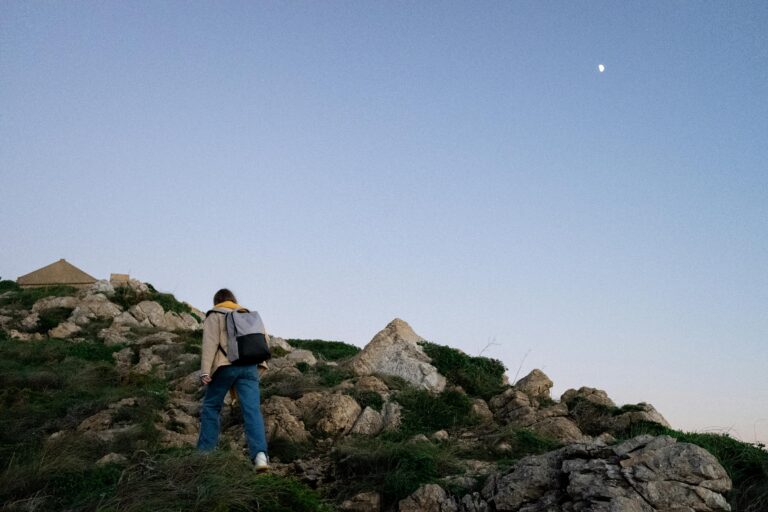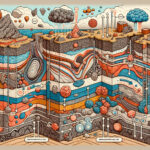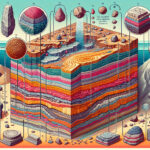The Rock Cycle Journey: An Overview
Imagine Earth as a grand artist, tirelessly sculpting mountains and carving valleys. Among the materials in Earth’s artistic palette are the humble sedimentary rocks, layered pieces of history waiting for a metamorphosis into something even more remarkable. How do these layered stones embark on a transformation journey to become the stunning metamorphic marvels we find today? Let’s dive into the essence of this natural masterpiece.
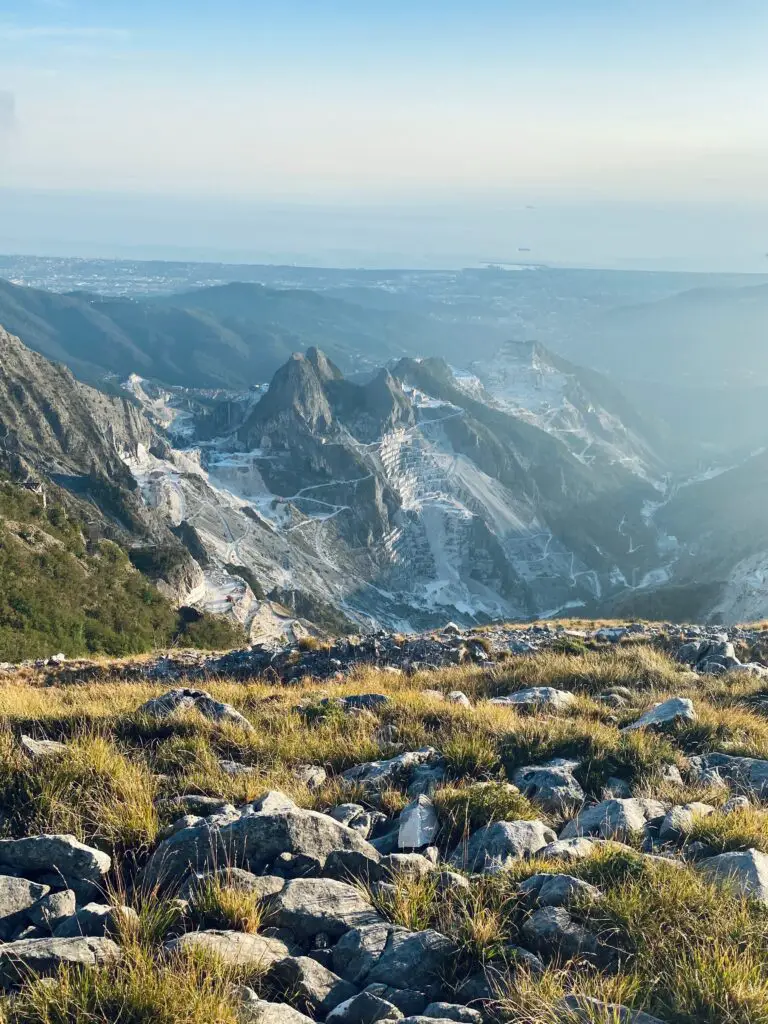
Our story begins with sedimentary rocks, those picturesque strata found lining the river beds or resting in silent deserts. Through the life cycle of rocks, we see these sedimentary layers exposed to intense heat and pressure deep within Earth’s crust—the kind of pressures that would turn coal into a diamond. And much like an uncut gem, sedimentary rocks hold potential beneath their rough surface.
The saga of their transformation is nothing short of geological alchemy. As tectonic plates shift and continents collide, our sedimentary protagonists are buried and subjected to temperatures and pressures unlike anything we experience on the surface. These extreme conditions don’t melt the rocks; instead, they cook them in Earth’s crucible, rearranging their minerals into new patterns, weaving textures and strengthening their forms.
Imagine clay-rich shale as it undertakes this metamorphic journey. Over millions of years, the heat and pressure meld its particles together, hardening it into slate, a stone sturdy enough to roof our homes and resilient against the elements. With even more time and transformative energy, that very slate can evolve into phyllite, then schist, and ultimately, into glistening gneiss—each metamorphic stage more intricate than the last.
Through the rock cycle, the Earth demonstrates its dynamic nature and reminds us of the ever-changing world beneath our feet. To truly appreciate the beauty of metamorphic rocks, one must grasp the vast timescales and powerful forces at play—forces powerful enough to take humble layers of sediment and craft them into timeless metamorphic marvels.
Unveiling Sedimentary Rocks: Composition and Formation
Imagine strolling along a tranquil beach, where each grain of sand whispers tales of ancient landscapes. These grains are the unsung heroes in the grand narrative of sedimentary rocks. But how do these scattered fragments of the Earth’s crust amalgamate to etch the story of sedimentary rocks into the tapestry of geology? Let’s unravel this geological mystery together.
Sedimentary rocks begin their journey as mere particles—fragments of minerals, shells, and even microscopic organisms, all bequeathed by the natural crumbling of older rocks. It’s a process as old as time, steered by the Earth’s own rhythms: the relentless cycle of weathering and erosion. Picture a grand mountain range, incessantly battered by the elements until each behemoth is reduced to vulnerable rubble, ready to embark on a transformative odyssey.
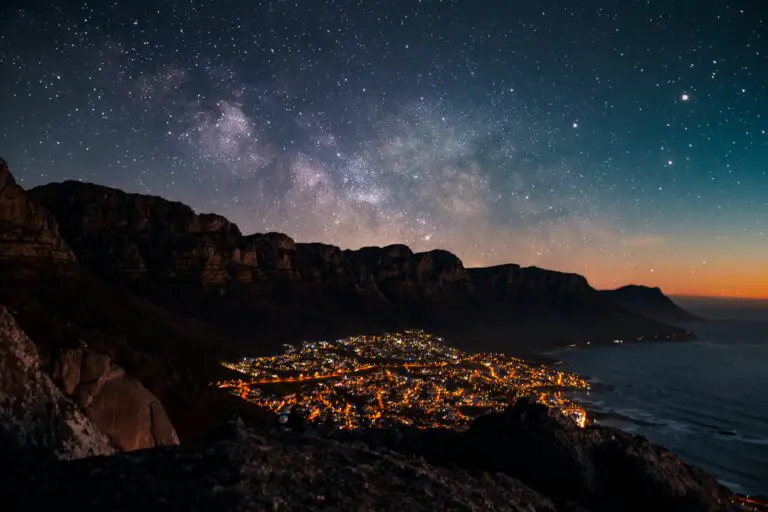
These tiny vagabonds of stone and shell are carried by water and wind, traversing across continents, destined for basins where they settle in quiet resignation. Here, in their final resting place, they are layered, one over the other, in a slow dance of accumulation. Pressed and compacted by the weight of overlying materials, these sediments undergo lithification, a process that cements them into the solid rock we encounter in the stratified cliffs and serene plateaus that grace our planet.
The transformation from solitary grains to solid rock is not just a story of pressure, though. It’s a tale laced with chemistry, as fluids percolate through the sediment, depositing minerals that act as a glue to bind these particles firmly together. This cementation can be witnessed in the iconic sandstone arches and limestone caverns that stand as natural monuments to the resilience and strength of sedimentary rocks.
Throughout the world, from the rolling red dunes of the Sahara to the rugged cliffs of the Grand Canyon, sedimentary rocks chronicle Earth’s past environments and climates. In their layers, they preserve fossils and remnants of historical biomes, captivating scientists and adventurers alike with their ability to unlock the secrets of an ancient world long gone.
So, as we stand on the edge of a sediment-laden river or gaze upon a stratified rock face, we’re not just seeing rocks. We’re witnessing the pages of Earth’s diary, etched in stone, revealing the epic, transformative journey from sediment to solid rock—a transformation that, under the right conditions, can ultimately lead these sedimentary characters to their next metamorphic stage in the geological theater. And that, my friends, is a story for another day.
Metamorphism Mechanics: Heat, Pressure, and Chemical Processes
Imagine the earth’s mighty forces at work, where simple sediments bind together to lay the foundation for pinnacles shimmering with crystal veins. This is no fantasy; it’s the very real transformation of sedimentary rocks into metamorphic marvels—a process packed with drama and driven by heat, pressure, and incredible chemical reactions.
The Heat Is On: Cooking Up Metamorphic Rocks
Heat is the ultimate chef in the kitchen of metamorphism. It’s not just about a gentle simmer; we’re talking temperatures ranging from 200°C to 800°C! Picture layers of sedimentary rock buried deep within the earth, where they’re heated without melting. Now, imagine the minerals in these rocks beginning to dance and realign, forming new, stable structures fit for the extreme conditions—it’s like baking cookies, but the dough rearranges itself into a whole new pastry!
Under Pressure: When the Earth Embraces Sedimentary Rocks
Squeezed between tectonic plates or buried under mountains of additional layers, sedimentary rocks find themselves under immense pressure, ranging from a few hundred to several thousand times atmospheric pressure. This colossal squeeze pushes minerals closer, prompting them to recrystallize into denser arrangements. It’s akin to packing your suitcase for a long vacation, where you must fit everything into a tiny space, forcing your clothes (or, in this case, minerals) to fold and compress, leaving no room for wasted space.
Chemical Alterations: Adding Spice to the Rock Recipe
Metasomatism, the process where fluids introduce or subtract chemical components, is like adding spices to a dish—it alters the rock’s very essence. As hot fluids percolate through the rocks, they can dissolve original minerals and deposit new ones, creating a metamorphic rock with flavors entirely its own. Imagine how a splash of wine can transform a stew; similarly, these fluids enrich the rock, bestowing upon it qualities that the original sedimentary rock never possessed.
Throughout this metamorphic journey, the rocks can develop telltale textures and structures such as foliation, a layering that occurs when minerals reorient themselves perpendicular to the direction of pressure. This gives rise to rocks like slate and schist, which, unlike the pages of a book, can reveal the history written by the earth’s hand.
In the grand tale of geology, the transformation from sedimentary to metamorphic rocks is a captivating chapter, rich with nuance and grandeur. As beholders of these natural processes, we stand in awe, appreciating the silent yet monumental shifts occurring deep beneath our feet, a transformation that tells the story of our dynamic planet.
The Textural Transition: From Sedimentary to Metamorphic
Imagine you’re witnessing the grandest of transformations, not in a butterfly, but in a rock! Sedimentary rocks, renowned for capturing Earth’s history page by page, undergo a dramatic makeover, swapping their old attire for the elegant garb of metamorphic rocks. This metamorphosis initiates as the rocks venture from the surface deep into the Earth’s crust, where pressure and temperature conditions opt for a no-nonsense wardrobe change.
Under this intense environment, minerals within the sedimentary rocks begin to reorient themselves. Much like the organized chaos of a crowded mega event, minerals line up along planes of least resistance, creating a signature feature known as foliation. The once randomly scattered particles in sedimentary rocks now follow a strict alignment, resulting in a banded or layered appearance. This textural shift isn’t merely for aesthetics; it’s a testament to the immense pressure that coerces the minerals into parallel conformity.
A compelling instance of this textural evolution is the transformation of clay-rich shale into slate. Slate, the sophisticated cousin in the metamorphic family, owes its fine-grained uniformity to high pressure, compelling clay minerals to recrystallize into tiny micas. This process isn’t just an inconspicuous affair; the result is a rock that not only looks different but can also be split into thin, durable sheets, revolutionizing its uses in architecture and beyond.
But the stage of metamorphism isn’t exclusive to pressure—temperature plays a leading role too. As temperatures soar, new minerals crystalize, creating a mosaic of textures unique to metamorphic rocks. This high-temperature mineralogy club is picky, allowing only members stable under specific conditions. Imagine sedimentary limestone rehearsing under the heat and emerging as the brilliant marble; a true metamorphic marvel admired by sculptors and builders alike.
This dramatic textural transition is a remarkable narrative of resilience and adaptability, a story best told by the rocks themselves. Fascinated by this rocky real estate? Check out the Science Notes article on rock types for a broader idea of where our solid friends belong in the vast planetary puzzle.
Unlock the visual journey of a rock’s transformation with this engaging video that illustrates the profound changes from sedimentary complacency to metamorphic complexity. Witness how metamorphism doesn’t just rearrange the rock’s existing wardrobe but introduces an entirely new collection of mineral ensembles.
Let’s not forget the equally significant metamorphic processes happening right under our feet, exploring the depths of our website’s detailed guide on the metamorphism process.
“`html
Mineral Magic: Recrystallization and New Mineral Formation
Imagine you’re sipping your favorite hot beverage. As the temperature rises, the sugar crystals at the bottom of the cup start to dissolve and then recrystallize on your spoon when you stir it. Something similar happens in the heart of our planet. Deep within Earth’s crust, sedimentary rocks are quietly brewing in conditions of intense heat and pressure, setting the stage for a magnificent transformation.
Recrystallization is the pivotal process where minerals in the rock, much like our sugar crystals, undergo changes in their crystalline structure without melting into liquid form. It’s the geological equivalent of a caterpillar turning into a butterfly inside its cocoon. Under metamorphic conditions, old minerals may dissolve, and new minerals crystallize, often becoming denser and more stable at the higher temperatures and pressures.
This mineralogical metamorphosis doesn’t happen overnight. It can take millions of years for the conditions to brew the perfect metamorphic rock recipe. Think of the Himalayas, for instance, where the collision of continental plates creates mountains and exposes sedimentary rocks to the metamorphic forces that craft the iconic, majestic peaks.
As the process unfolds, the rock’s characteristics evolve. Its texture, composition, and even the arrangement of its mineral grains transform. The result? Metamorphic rocks that are harder and more resilient than their sedimentary ancestors, with new mineral assemblages that tell the tale of their fiery renaissance. These rocks don’t just sit idle; they can become the foundations for new mountain ranges or the raw material for human creativity in sculptures and buildings.
The following video provides a visual journey of how rocks undergo metamorphism and recrystallization, showing the magnificent processes that happen beyond our sight:
Alas, even though we’ve delved into the depths where sedimentary rocks are woven into metamorphic tapestries, we’re only scratching the surface. To grasp the full extent of this geological alchemy, we invite you to explore further the complexities of metamorphic rock formation and uncover more secrets locked within the stone.
“`
A Tale of Two Metamorphisms: Contact vs. Regional
Envision the Earth’s rocky crust as a colossal canvas where minerals and elements mingle under heat and pressure to create art; namely, metamorphic rocks. Two primary artists in this geologic gallery are contact metamorphism and regional metamorphism. Both sculpt sedimentary rocks into metamorphic masterpieces, but their techniques and tools differ remarkably.
Let’s unpack the concept of contact metamorphism. Picture a slumbering city of sedimentary rocks, suddenly awakened by the intense heat from a magma intrusion, much like a flame unexpectedly grazing the edge of a paper. This intense heat has the power to bake and transform the nearby rocks into new, more robust forms—the process known as contact metamorphism. This localized thermal ordeal typically doesn’t involve much pressure or deformation, keeping the changes close-knit and personal. Imagine finding a vein of precious marble discretely tucked away next to an intrusive granite pluton—a silent testimony to a fiery encounter.
Now, imagine a far more epic transformation – regional metamorphism. This is not a localized event but a grand shift that unfolds across vast territories, often linked to mountain-building episodes known as orogenies. Here, the sedimentary rocks are not only heated but also squeezed under immense pressure and bent by the forces of tectonic plates crushing against each other. This extensive metamorphic makeover can birth a wide range of metamorphic rocks, from the layered slate found in roofing materials to the durable schist that might adorn luxurious building facades.
In essence, contact metamorphism is akin to the delicate touch of a brush upon a canvas, while regional metamorphism resembles a potter’s firm hands shaping clay on a wheel. Both create beauty under stress, but their scales and the marks they leave behind are worlds apart.

While contact metamorphism artistically transforms rocks at points where they kiss the magma, regional metamorphism does so across monumental scales, rewriting the rocky narratives of whole regions. They both remind us that beauty often arises from the pressures of life, even in the hard, enduring archive of Earth’s geological record.
Case Studies: Examples of Metamorphic Rocks and Their Origins
Imagine you’re holding a piece of slate, feeling its smooth layers and the solid weight of its dark form. It’s hard to believe that this metamorphic marvel was once squishy mud at the bottom of an ancient sea! But how did this radical transformation occur? Let’s dive into some awesome real-world examples and unravel the stories of metamorphic rocks and their fantastic formations.
From Sea to Summit: The Tale of Slate
Our journey starts with slate, known for roofing tiles and old-school chalkboards. Once upon a time, this rock began as shale, a muddy sedimentary stone found under the ocean. Tectonic plates decided to shuffle things up, pushing the soft shale deep into the Earth’s crust. As the temperature rose and pressure mounted, a magical change began. The shale, composed of microscopic clay, transformed into the fine, foliated layers of slate. In Wales, for example, the Snowdonia region showcases this transformation beautifully, with remnants of the ancient seas now sitting proudly atop breathtaking peaks.
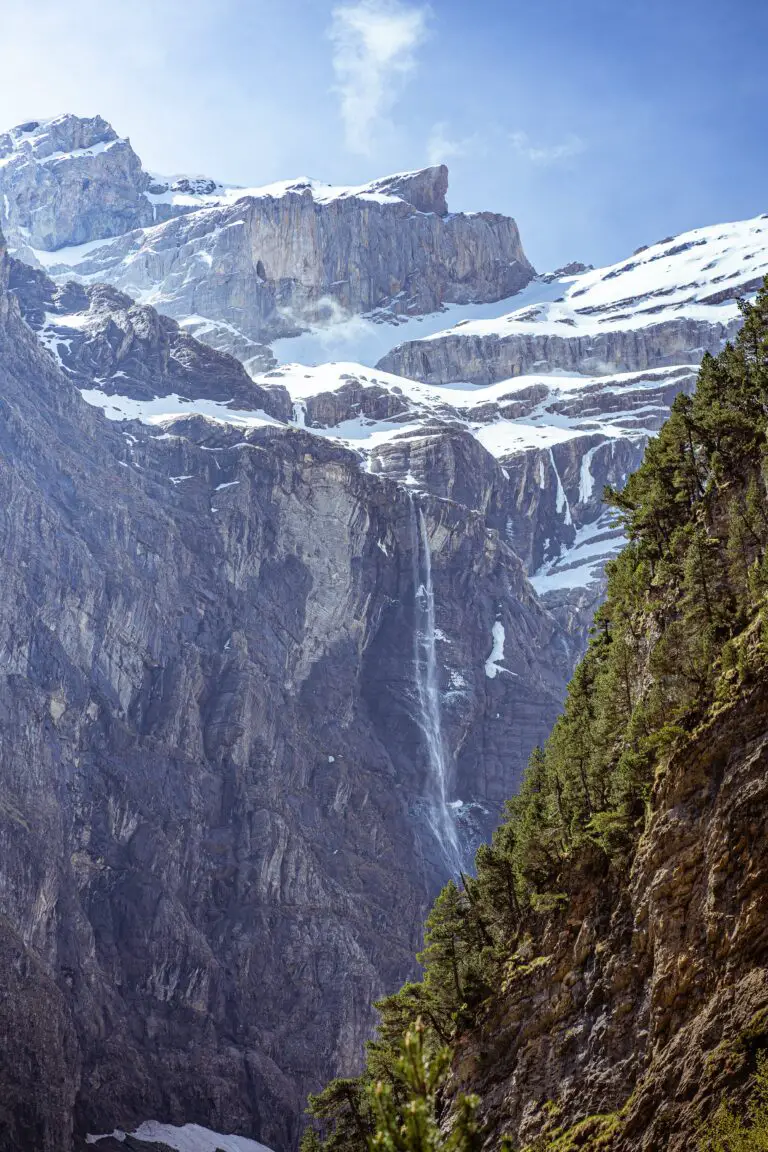
A Marbleous Journey: From Limestone to Magnificence
Take a look at the iconic marble, a symbol of purity and elegance. In Italy, the Carrara region’s towering white marble cliffs stand as a testament to metamorphism. Before being carved into sculptures by the likes of Michelangelo, this rock was simply limestone, composed mostly of skeletal fragments of marine organisms. Then, over millennia, the limestone was introduced to intense heat and pressure through the Earth’s dynamic processes, causing the minerals to recrystallize and transform into the luxurious marble we cherish today.
From Sandy Shores to Sparkling Quartzite
Lastly, let’s hit the beach – not for sunbathing, but to discuss sandstone’s evolution into quartzite. Sandstone, made of bonded grains of quartz, is a common sedimentary rock found in deserts and beaches. In places like Utah’s Wasatch Mountains, the sandstone underwent extreme heat and pressure, creating interlocking quartz crystals. This process is like baking cookies: individual ingredients merge to create something entirely new and delightful. The result is quartzite, a rock so durable you could chip a diamond on it!
Each piece of metamorphic rock tells a story of change, resilience, and the power of the natural world. Understanding these stones’ backstories isn’t just about science; it’s about appreciating the dynamic art of our planet. After all, if Mother Nature can turn the ordinary into the extraordinary, just imagine what else is possible!
Metamorphic Rocks and Earth’s Landscape
Have you ever gazed upon the grandeur of towering mountain ranges and felt a sense of awe? These natural skyscrapers are often the handiwork of metamorphic rocks, the unsung heroes of Earth’s rugged beauty. Metamorphic rocks arise from the transformation of sedimentary rocks under the spell of intense pressure and heat deep within the Earth’s crust. The journey these rocks undergo is nothing short of a geological makeover, one that equips them with the strength to shape our planet’s surface in monumental ways.
Consider the mighty Himalayas, where the metamorphic marvels gneiss and schist make up much of the jagged peaks that pierce the sky. The collision of tectonic plates not only gave birth to these mountains but also set the stage for sedimentary rocks to metamorphose, joining forces to push the land upwards. The result? A mountain building extravaganza that continues to reshape the landscape even today. This tectonic tango is a testament to the might of metamorphic rocks—it’s as if Earth is flexing its muscles, showing us just how dynamic and alive our planet truly is.
Metamorphic rocks don’t just build mountains; they’re also the silent witnesses to the relentless grind of tectonic activity beneath our feet. Every time there’s a shift or shuffle down there, these rocks record the event, telling stories of Earth’s past movements and changes. They’re essentially Earth’s historians, with each layer and line revealing a new chapter of our planet’s tumultuous tale.
What’s more, these incredible rocks often play a vital role in our quest for resources. From the statuesque marbles gracing our artistic endeavors to the slate roofs sheltering our homes, the presence of metamorphic rocks weaves through the fabric of human civilization. Their resilience and versatility make them invaluable players in both our cultural heritage and modern industry.
So, next time you’re out admiring natural landscapes or venerating human-made marvels, pause for a moment and consider the eventful journey of the rocks beneath your fingertips. From sedimentary beginnings to metamorphic milestones, these rocks are the robust foundation upon which the drama of Earth’s landscape unfolds. To truly grasp the scale of their impact, dive into the world of metamorphic rocks with this enlightening video:
Frequently Asked Questions
Ever peered at a marble wall and wondered about its regal past? It all starts with sedimentary rocks, Earth’s historical archives, which under the right conditions can transform into majestic metamorphic marvels. Let’s tackle some curiosities you might have about this rockin’ process!
What kick-starts the metamorphosis of sedimentary rocks?
Imagine a sedimentary rock lounging at the bottom of an ocean. Over time, layers of sand, silt, and dead organisms pile up on top, burying it deeper into the Earth. This burial triggers a high-pressure, high-temperature makeover known as metamorphism, cueing the sedimentary rock’s transformation into a band member of the metamorphic rock group!
Do all sedimentary rocks morph the same way?
Each sedimentary rock has its own unique backstory and composition, think of it as their DNA. Depending on their mineral makeup and the specific conditions they’re subjected to, they change in different ways. Some might become the elegant marbles that grace our countertops, while others emerge as the leather-look schists that landscape designers covet.
Can you spot an ‘in-between’ stage during this transformation?
Just like a snapshot of a caterpillar halfway into its chrysalis, geologists can sometimes catch sedimentary rocks mid-transformation. These transitional rocks give us invaluable clues about the extreme underground conditions that nudged them along their metamorphic journey.
Are there tell-tale signs a sedimentary rock is gearing up for a metamorphic glow-up?
Yep, they don’t just change overnight! Tell-tale textures and mineral alignments spring up, whispering secrets about the rock’s impending shift. The intricate layers within a sedimentary rock start to fold, meld, and recrystallize, revealing the coming-of-age tale of a metamorphic rock.
What’s the coolest thing you’ll witness in this transformation?
Witnessing the birth of new minerals is the geological equivalent of a fireworks show. As the rock endures more pressure and heat, new, flamboyant mineral grains emerge and grow, flaunting their colors and patterns within the rock, like vibrant threads in a once plain weave.
Real-life examples? Think of the mighty Himalayas, which began as sediments in the vast Tethys Sea, only to rise up and become the towering, gneiss peaks we’re in awe of today.
